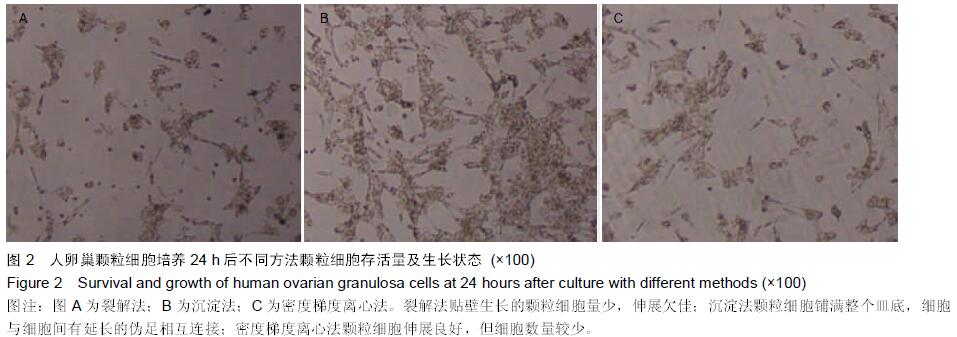[2] Shi Ft, Cheung AP, Huang HF, et al. Growth differentiation factor 9 (GDF9) suppresses follistatin and follistatin-like 3 production in human granulose-lutein cells. PloS One.2011; 6(8):e22866.
[3] Yata A, Nakabayashi K, Wakah ashi S, et al. Suppression of progesterone production by stresscop in/ urocortin 3 in cultured human granulose-lutein cells. Hum Reprod, 2009; 24(7):1748-1753.
[4] Ma M, Wang J, Xu L,et al.Effects of two human chorionic gonadotropin doses administered to the ovarian states during the <i>in vitro</i> fertilization and embryo transfer program. Biomed Rep. 2015;3(2):215-219.
[5] Liang Y, Du HL, Chang XF,et al.[Effect of bushen tiaojing recipe on the quality of the oocytes and reproductive hormones in the follicular fluid in IVF-ET patients].Zhongguo Zhong Xi Yi Jie He Za Zhi. 2014;34(8):911-916.
[6] Simopoulou M, Nikolopoulou E, Dimakakos A,et al. Cell adhesion molecules and in vitro fertilization.In Vivo. 2014; 28(5):683-690.
[7] Song CM, Yang HM, Lu J,et al. [Effect of Bushen Tiaojing Recipe containing serum on FSH/cAMP-PKA pathway in in vitro cultured human ovarian granular cells].Zhongguo Zhong Xi Yi Jie He Za Zhi. 2014;34(3):317-323.
[8] Gao X, Chang X, Du H,et al.Effect of soothing liver therapy on oocyte quality and growth differentiation factor-9 in patients undergoing in vitro fertilization and embryo transfer.J Tradit Chin Med. 2013;33(5):597-602.
[9] Mehta BN, Chimote MN, Chimote NN, et al. Follicular-fluid anti-Mullerian hormone (FF AMH) is a plausible biochemical indicator of functional viability of oocyte in conventional in vitro fertilization (IVF) cycles.J Hum Reprod Sci.2013;6(2): 99-105.
[10] Jin HX, Xin ZM, Song WY,et al.Effects of human cumulus cells on in vitro fertilization outcomes and its significance in short-term insemination.J Reprod Med. 2013;58(1-2):51-54.
[11] Karuputhula NB, Chattopadhyay R, Chakravarty B,et al. Oxidative status in granulosa cells of infertile women undergoing IVF.Syst Biol Reprod Med. 2013;59(2):91-98.
[12] Havelock JC, Rainey WE, Carr BR. Ovarian granulose cell lines. Mol Cell Endocrinol.2004;228(1): 67-78.
[13] 叶婧,丁婷,杜小芳,等.不同分离方法对人卵巢颗粒细胞体外培养的影响 [J].中国现代医学杂志,2013,23(17):1-5.
[14] Sutton ML, Gilchrist RB, Thompson JG. Effects of in-vivo and in-vitro environments on the metabolism of the cumulus-oocyte complex and its influence on oocyte developmental capacity. Hum Reprod Update. 2003;9(1): 35-48.
[15] Liu JY, Qian Y, Mao YD, et al. In vitro maturation, fertilization and embryo transfer of human immature oocyte. Zhonghua Fu Chan Ke Za Zhi.2003 ;38(4):230-232.
[16] Somigliana E, Viganò P, La Sala GB,et al. Follicular fluid as a favourable environment for endometrial and endometriotic cell growth in vitro. Hum Reprod.2001; 16(6):1076-1080.
[17] Malamitsi-Puchner A, Sarandakou A, Baka SG, et al. Concentrations of angiogenic factors in follicular fluid and oocyte-cumulus complex culture medium from women undergoing in vitro fertilization: association with oocyte maturity and fertilization. Fertil Steril.2001;76(1):98-101.





